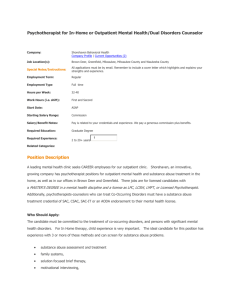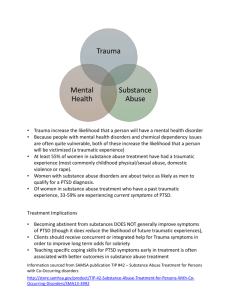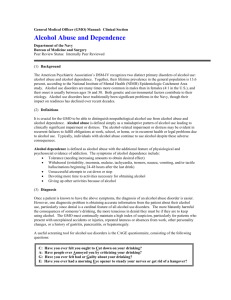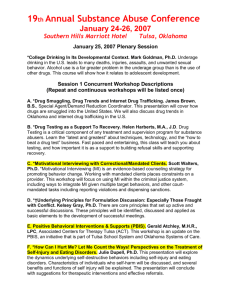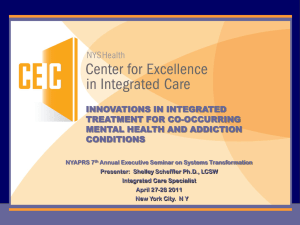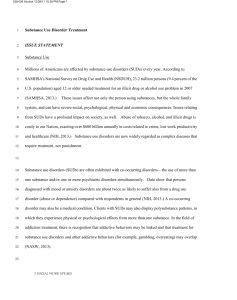An Outline for the Report of the Subcommittee on Suicide Prevention
advertisement
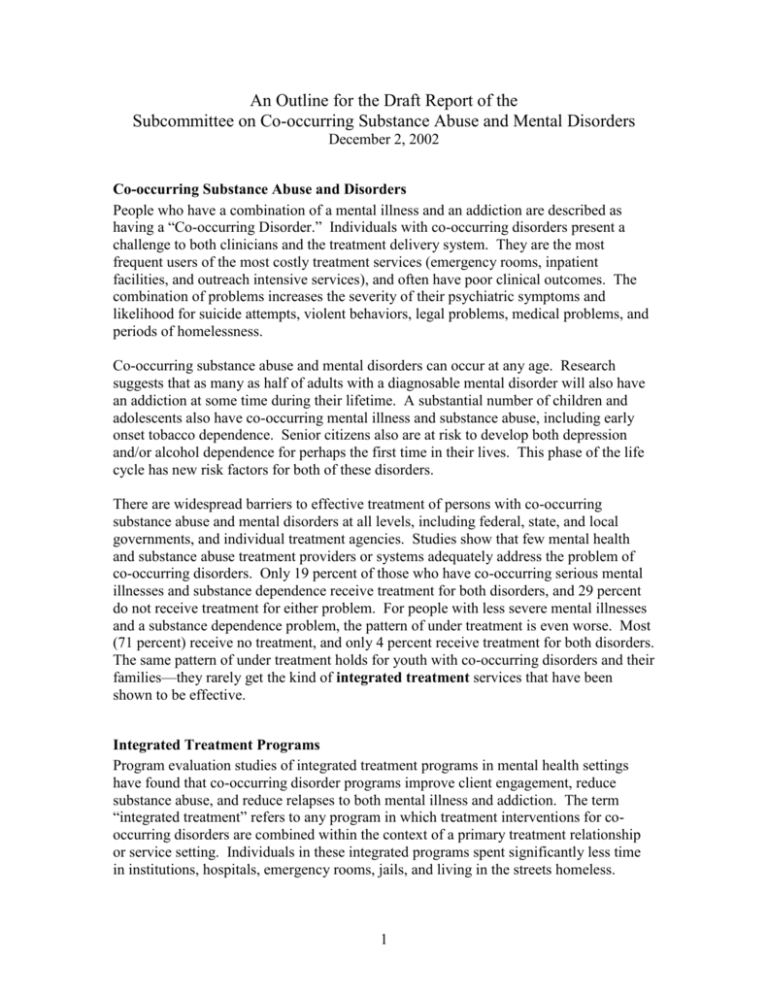
An Outline for the Draft Report of the Subcommittee on Co-occurring Substance Abuse and Mental Disorders December 2, 2002 Co-occurring Substance Abuse and Disorders People who have a combination of a mental illness and an addiction are described as having a “Co-occurring Disorder.” Individuals with co-occurring disorders present a challenge to both clinicians and the treatment delivery system. They are the most frequent users of the most costly treatment services (emergency rooms, inpatient facilities, and outreach intensive services), and often have poor clinical outcomes. The combination of problems increases the severity of their psychiatric symptoms and likelihood for suicide attempts, violent behaviors, legal problems, medical problems, and periods of homelessness. Co-occurring substance abuse and mental disorders can occur at any age. Research suggests that as many as half of adults with a diagnosable mental disorder will also have an addiction at some time during their lifetime. A substantial number of children and adolescents also have co-occurring mental illness and substance abuse, including early onset tobacco dependence. Senior citizens also are at risk to develop both depression and/or alcohol dependence for perhaps the first time in their lives. This phase of the life cycle has new risk factors for both of these disorders. There are widespread barriers to effective treatment of persons with co-occurring substance abuse and mental disorders at all levels, including federal, state, and local governments, and individual treatment agencies. Studies show that few mental health and substance abuse treatment providers or systems adequately address the problem of co-occurring disorders. Only 19 percent of those who have co-occurring serious mental illnesses and substance dependence receive treatment for both disorders, and 29 percent do not receive treatment for either problem. For people with less severe mental illnesses and a substance dependence problem, the pattern of under treatment is even worse. Most (71 percent) receive no treatment, and only 4 percent receive treatment for both disorders. The same pattern of under treatment holds for youth with co-occurring disorders and their families—they rarely get the kind of integrated treatment services that have been shown to be effective. Integrated Treatment Programs Program evaluation studies of integrated treatment programs in mental health settings have found that co-occurring disorder programs improve client engagement, reduce substance abuse, and reduce relapses to both mental illness and addiction. The term “integrated treatment” refers to any program in which treatment interventions for cooccurring disorders are combined within the context of a primary treatment relationship or service setting. Individuals in these integrated programs spent significantly less time in institutions, hospitals, emergency rooms, jails, and living in the streets homeless. 1 Integrated treatment is a means of coordinating substance abuse and mental health interventions to treat the whole person more effectively; the services should appear seamless to the individual seeking and receiving care. Mental health and substance abuse treatment can be integrated by one clinician, two or more clinicians working together, one program, or a network of services. Integrated treatment often involves other systems as well, because individuals with co-occurring disorders typically have a wide range of health and social service needs. A key challenge to the development of integrated treatment programs is the traditional separation of mental health and substance abuse treatment. At least 36 states are attempting some level of systems change effort to address this problem. Studies of these efforts have shown that state and local regulatory issues, and impediments in the use of multiple state and local funding streams, including Medicaid, are the major barriers to systems change. These barriers can generally be overcome by creative leadership with a sustained vision, and engagement of strong local stakeholder support (including consumers and families) in program design and advocacy. Policy Options 1. All federally-funded health, human services, and criminal justice programs should include co-occurring substance abuse and mental disorders as an expectation in program design, development of program standards, and monitoring of clinical outcomes and quality indicators. 2. The Substance Abuse and Mental Health Services Administration (SAMHSA) Administrator should issue a directive establishing a visible focus of authority and responsibility for co-occurring disorder-related issues with direct reporting to the Administrator. This entity would coordinate existing activities in this area by SAMHSA agencies (the Center for Mental Health Services, the Center for Substance Abuse Treatment, and the Center for Substance Abuse Prevention), and coordinate linkages with other Federal agencies regarding co-occurring substance abuse and mental disorders. In addition, it would promote new functions and activities, including implementing a collaborative process with states and the private sector to reach consensus definitions of “co-occurring disorders” and “integrated cooccurring disorder treatment,” and develop accompanying specific, measurable performance standards. 3. The Secretary of Health and Human Services (DHHS) should issue a directive that all health training programs receiving DHHS funding include co-occurring substance abuse and mental disorders as an expectation in curriculum design. Too few clinicians have been dually trained to treat individuals with both addiction and mental illness. Excellent training programs have been developed for all disciplines and specialties. Evidence-based technology transfer must include training clinical leadership and supervisory staff. 2 4. The SAMHSA Administrator should issue a directive to launch a major federal/state initiative to foster system change initiatives at the state and local (regional, county) level. Such effort would aim to improve utilization of existing resources through integration of system planning, elimination of regulatory barriers, creation of regulatory and funding incentives, and dissemination/ implementation of best practice programs, interventions, and services for individuals with co-occurring substance abuse and mental disorders. The SAMHSA Office of Co-occurring Disorders could coordinate with the regional Technology Transfer Centers to disseminate information to state and local systems regarding evidence-based practices, and provide technical assistance and consultation to support state system change initiatives. 5. The Secretary of DHHS should issue a directive to require collaboration between SAMHSA and the Center for Medicare and Medicaid Services (CMS) to develop and implement policy guidance to promote access and utilization of appropriate services by Medicaid and Medicare beneficiaries with co-occurring substance abuse and mental disorders. 6. The NIH Administrator should issue a directive to launch a major federal research initiative on co-occurring substance abuse and mental disorders through the development of an Office of Co-occurring Disorders Research with a mandate to increase interagency collaboration in the development of co-occurring disorder research proposals, including supporting new investigator and other research career awards aimed to address co-occurring disorders. 7. The SAMHSA Administrator should issue a directive to encourage investment of existing Mental Health Block Grant and Substance Abuse Prevention and Treatment Block Grant funding in prevention efforts directed specifically at cooccurring substance abuse and mental disorders, under the coordination of the Office of Co-occurring Disorders. 8. The Secretaries of the Department of Health and Human Services, the Department of Justice (Attorney General), and the Department of Education should issue a joint directive to mandate that co-occurring substance abuse and mental disorders are routinely addressed and integrated into every initiative relating to either mental health or substance abuse in every human service setting. The new requirements would include comprehensive screening and identification for both disorders in all federally funded correctional, criminal, or juvenile justice programs. The federally funded behavioral health programs in criminal justice or correctional programs would also be required to provide treatment services that meet dual diagnosis capability standards. 3

